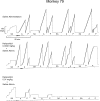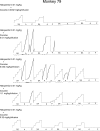Differential antagonism of cocaine self-administration and cocaine-induced disruptions of learning by haloperidol in rhesus monkeys
- PMID: 18422020
- PMCID: PMC2251325
- DOI: 10.1901/jeab.2008.89-225
Differential antagonism of cocaine self-administration and cocaine-induced disruptions of learning by haloperidol in rhesus monkeys
Abstract
Six rhesus monkeys responding under a three-component multiple schedule were administered haloperidol to determine its effects on cocaine self-administration and on cocaine's disruptive effects on the repeated acquisition and performance of response chains. In the absence of haloperidol, 0.0032-0.032 mg/kg/infusion of cocaine increased response rate and the number of infusions in the self-administration component when compared to saline administration, whereas 0.1-0.32 mg/kg/infusion decreased response rate and the number of infusions. When compared to saline administration, the two lowest infusion doses of cocaine had little or no effect on responding in the acquisition and performance components; however, higher infusion doses of cocaine dose-dependently decreased response rate in these components. In addition, the higher doses of cocaine also increased the percentage of errors in the acquisition and performance components. Pretreatment with haloperidol (0.0032 or 0.01 mg/kg, i.m.) antagonized the effects of low doses of cocaine on the number of infusions in the self-administration component, whereas only the 0.01-mg/kg dose antagonized the effects of high doses of cocaine on the number of infusions. Neither dose of haloperidol antagonized the rate-decreasing effects of cocaine on responding in the acquisition and performance components significantly; the highest dose of haloperidol alone decreased rates of responding in each component. Antagonism of cocaine's error-increasing effects by haloperidol was only evident at one dose of cocaine (0.032 mg/kg/infusion), and was more complete in the performance components than in the acquisition components. Together, these data show the limited suitability of haloperidol for selectively antagonizing cocaine self-administration in the context of a multiple schedule involving transition behavior, and show the lack of uniform antagonism across operant behaviors.
Figures






References
-
- de la Garza R, Johanson C.E. Effects of haloperidol and physostigmine on self-administration of local anesthetics. Pharmacology, Biochemistry and. Behavior. 1982;17:1295–1299. - PubMed
-
- Dworkin S.I, Mirkis S, Smith J.E. Reinforcer interactions under concurrent schedules of food, water, and intravenous cocaine. Behavioural Pharmacology. 1990;1:327–338. - PubMed
-
- Foltin R.W. Effects of dietary and pharmacological manipulations on appetitive and consummatory aspects of feeding in non-human primates. Appetite. 2005;45:110–120. - PubMed
-
- Gawin F.H. Neuroleptic reduction of cocaine-induced paranoia but not euphoria? Psychopharmacology (Berl.) 1986;90:142–143. - PubMed
-
- Glowa J.R, Wojnicki F.H. Effects of drugs on food- and cocaine-maintained responding, III: Dopaminergic antagonists. Psychopharmacology (Berl.) 1996;1996.Dec., 128:351–358. - PubMed
Publication types
MeSH terms
Substances
Grants and funding
LinkOut - more resources
Full Text Sources
Medical

